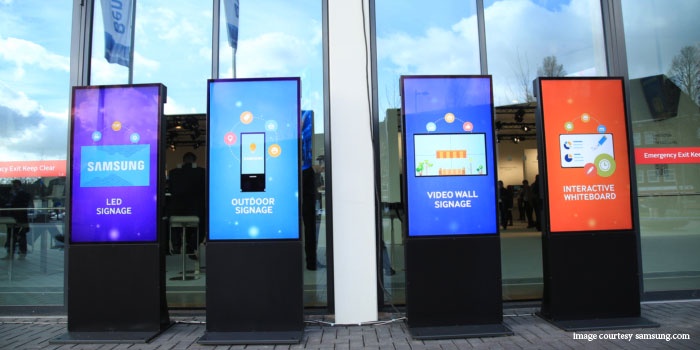
Digital Signage Comparison
Digital Signage Comparison In today's dynamic business landscape, effective communication with customers, employees, and visitors is paramount. Digital signage has emerged as a powerful tool to engage audiences and deliver information in a visually appealing manner. With the increasing number of digital signage solutions available.
Introduction:
Digital Signage Comparison Selecting the right one for your business can be overwhelming. This article aims to provide a comprehensive comparison of different digital signage options, helping you make an informed decision that aligns with your specific needs.
1. Understanding Digital Signage:
Digital signage is a display technology that utilizes LCD, LED, or projection screens to showcase multimedia content, such as images, videos, text, and animations. It is commonly used in retail stores, corporate offices, educational institutions, transportation hubs, and other public spaces to convey information, promote products, and enhance brand visibility. To make an effective comparison, let's explore various aspects of digital signage systems.
2. Types of Digital Signage Solutions:
a) Cloud-Based Solutions: Cloud-based digital signage platforms store content and data in the cloud, allowing remote management and access from anywhere with an internet connection. They offer flexibility, scalability, and real-time updates, making them ideal for businesses with multiple locations or distributed networks.
b) On-Premises Solutions: On-premises digital signage systems require hardware and software to be installed and managed locally. They offer more control over data and content but might be less convenient for businesses with a geographically dispersed presence.
c) Interactive Solutions: Interactive digital signage adds an extra layer of engagement by allowing users to interact with the displayed content. Touchscreen displays enable users to browse through product catalogs, and maps, or participate in surveys, fostering a more personalized experience.
3. Content Management Capabilities:
A critical factor in choosing a digital signage solution is the ease of content management. Look for features like:
a) User-Friendly Interface: An intuitive interface allows easy content creation, scheduling, and publishing, even for non-technical users.
b) Multi-Platform Support: Ensure that the solution is compatible with various devices and operating systems, such as Windows, Android, iOS, etc.
c) Content Scheduling: The ability to schedule content to be displayed at specific times and dates ensures your messages reach the right audience at the right time.
d) Content Templates: Pre-designed templates can simplify content creation and maintain a consistent branding strategy.
4. Display Quality and Hardware:
The visual impact of digital signage depends on the display quality and hardware used. Consider the following:
a) Resolution and Size: Higher resolution displays ensure sharper images and videos, while size should be chosen based on the viewing distance and available space.
b) Connectivity and Compatibility: Check if the hardware supports various media inputs, such as USB, HDMI, or Wi-Fi, for easy content transfer.
c) Durability and Maintenance: Depending on the installation environment, rugged and weather-resistant displays may be required.
d) Energy Efficiency: Opt for energy-efficient displays to minimize operational costs.
5. Scalability and Flexibility:
Your business might grow or undergo changes, so it's crucial to select a digital signage solution that can scale accordingly. Consider the following aspects:
a) Network Management: For businesses with multiple locations, a centralized network management system simplifies updates and ensures consistency across all displays.
b) Content Compatibility: Choose a solution that supports various media formats to keep up with changing content trends.
c) Integration: Look for solutions that can integrate with other systems, such as social media, weather forecasts, or data analytics tools, to provide more dynamic content.
6. Analytics and Performance Tracking:
Data-driven insights can help optimize your digital signage strategy. Analytical capabilities to look for include:
a) Audience Analytics: Features that capture data on viewer demographics, engagement rates, and popular content can help tailor your messaging.
b) Performance Metrics: Track the performance of individual displays to ensure they are operating correctly and attracting the desired attention.
c) Remote Monitoring: Real-time monitoring allows you to identify and address issues promptly.
7. Customer Support and Training:
Digital signage implementation and management might require technical support and training. Evaluate the customer support offered by the provider, including documentation, tutorials, and response times for addressing queries.
Conclusion:
As the digital signage market continues to expand, choosing the right solution is crucial to making the most of this powerful communication tool. By assessing factors like display quality, content management capabilities, scalability, and support options, you can find a digital signage solution that aligns perfectly with your business objectives. Investing in the right digital signage platform will not only enhance your brand's visibility but also provide a more engaging and personalized experience for your audience

Digital Signage Comparison: How It Works?
Digital signage is a powerful and effective communication tool that utilizes display screens to showcase multimedia content in various public spaces. It allows businesses, organizations, and institutions to engage their target audience, deliver information, and promote products or services in a visually appealing and dynamic manner. To understand how digital signage works, let's explore the key components and processes involved:
1. Hardware Components:
a) Display Screens: Digital signage relies on various display screens such as LCD (Liquid Crystal Display), LED (Light Emitting Diode), or projection screens. These screens come in different sizes and resolutions, enabling businesses to choose the most suitable option based on their specific needs and space requirements.
b) Media Players: Media players are small computing devices that are connected to the display screens. They store and play the multimedia content, including images, videos, text, and animations, on the screens. Media players can be standalone devices or integrated directly into the display screen itself.
c) Content Sources: The content displayed on digital signage screens can be sourced from various places, including on-site servers, cloud-based platforms, USB drives, or content management systems (CMS). Cloud-based solutions offer the advantage of remote content management and updates from any location with an internet connection.
2. Content Creation and Management:
a) Content Creation: Content for digital signage can be created using various tools, such as graphic design software, video editing software, and content authoring platforms. Businesses can design visually appealing graphics, create engaging videos, and curate informative text to be displayed on the screens.
b) Content Management System (CMS): A CMS is the backbone of digital signage management. It is software that allows users to upload, schedule, and organize content for display. The CMS also enables users to divide content into playlists, determine display schedules, and target specific screens or locations with relevant content.
c) Scheduling and Display: Using the CMS, content can be scheduled to appear at specific times and dates. This scheduling capability ensures that the right content reaches the target audience at the most appropriate times, enhancing the effectiveness of the digital signage strategy.
3. Connectivity and Control:
a) Connectivity: Digital signage systems require an internet connection for cloud-based content management, remote updates, and data analytics. For on-premises systems, content can be updated through local networks or USB drives.
b) Remote Control: With cloud-based solutions, digital signage can be controlled and managed remotely from any internet-connected device, providing flexibility and convenience to the users.
4. Interactivity (Optional):
Some digital signage installations incorporate interactive elements to engage the audience further. This is achieved through the use of touchscreens or sensors, enabling users to interact with the content. Interactive digital signage is commonly seen in retail environments for product browsing, wayfinding, and customer feedback surveys.
5. Analytics and Performance Tracking
Digital signage systems can provide valuable data and insights through analytics. This data includes information about audience demographics, engagement rates, popular content, and display performance. Analyzing these metrics can help businesses fine-tune their content strategy and optimize the impact of their digital signage efforts.
Conclusion:
Digital signage works by combining hardware components, content creation and management, connectivity, and optionally, interactive elements. By utilizing display screens, media players, and content management systems, businesses can deliver dynamic and engaging content to their target audience, enhancing brand visibility, improving communication, and providing valuable information in various public spaces. Whether deployed in retail stores, corporate offices, transportation hubs, or educational institutions, digital signage continues to revolutionize the way businesses connect with their audiences.


No comments yet